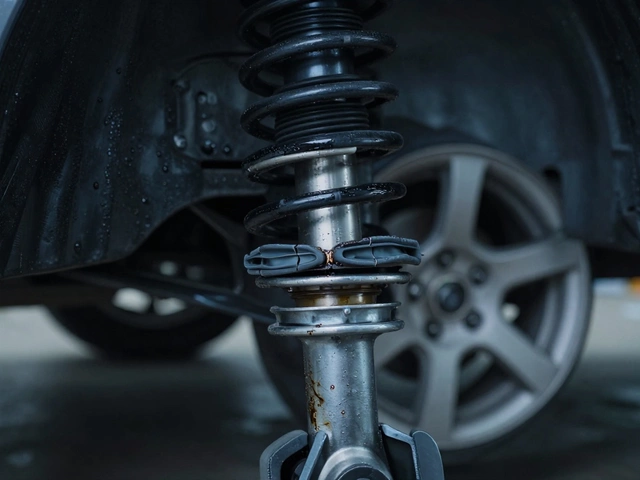Picture this: you're cruising down the road, pothole ahead. Instead of gliding over it, your car bounces like it’s got a mind of its own. Maybe the steering feels a bit sloppy, or you hear odd thumps every time you go over a speed bump. It's not just annoying—your car’s suspension might be crying out for help. Bad shocks or springs sneak up on you. They don’t always fail overnight, but the hints are loud enough if you know where to look. Being clued in could save you a fortune—and your next journey might be way smoother.
What Do Your Shocks and Springs Really Do?
Your car's suspension is a lot more than springs and fancy bits. Shocks and springs are the backbone—literally soaking up every little bump and pothole you find. Springs hold your car up and keep it steady, while shocks (or struts) handle the bounce so your tyres stay stuck to the road. When either one gets tired, things change fast. You're not just dealing with a rough ride; worn-out shocks mean your tyres lose grip, especially during hard braking or sharp turns. Ever wonder why Formula One teams swap suspension parts at the first sign of trouble? It’s not just speed but control. Car engineers know that even small changes in suspension performance can mean the difference between sticky handling and an accident at the next roundabout.
Here’s something most people miss: a modern shock will cycle up and down, on average, over two million times every 20,000 miles. Imagine doing two million squats with a spring in your hand—it’s not surprising they give out eventually. Your springs never stop working, supporting the car 24/7, even when parked. The difference in ride height between a new car and one with tired springs can be a couple of centimetres, enough to throw off alignment and tyre wear. In Manchester, where rain and potholes take their toll, abuse ramps up quickly. Manufacturers often recommend checking these parts every year or 12,000 miles, whichever comes first. Professional drivers do it even more often—no one’s a fan of mystery clunks or bouncy rides.
Warning Signs: How to Tell if Your Shocks or Springs Are Bad
So what are the classic giveaways? It’s not always a dramatic failure, like your car collapsing on one corner. Sometimes, the symptoms are subtle and sneak up on you, making your everyday drive an unpredictable game. Let’s start with the noticeable stuff: does your car feel like a boat after driving through a puddle—lots of up-and-down movement? That’s a red flag. Good shocks will dampen motion fast. When you press down on a corner of your car and let go, it should rise and settle in one move. If it keeps bouncing, that's usually the shock absorber talking. Springs are a little sneakier. Squeaky suspension noises, uneven gaps between the tyre and the wheel arch, or one side sitting lower than the other—all classic spring problems. Sometimes, a broken coil is hiding near the bottom or top of the spring, out of sight unless the car is lifted.
| Sign | Likely Cause | Quick Check |
|---|---|---|
| Bouncy ride over rough roads | Worn shocks | Bounce test at each corner |
| Uneven vehicle height | Broken or sagging spring | Measure ground-to-arch gap |
| Strange noises when turning | Cracked spring or loose mount | Visual check, listen while turning full lock |
| Car nose-dives when braking | Weak shock absorbers | Braking in a safe spot |
| Car pulls to one side | Damaged suspension or spring | Drive straight, check alignment |
If your steering feels loose or you can’t keep the car straight over bumps, that's your cue to look underneath. Another clue is tyre wear—if the inside or outside of your tread is wearing down faster, a bad shock or sagging spring could be messing with your alignment. Another sneaky symptom: leaks on your shock absorbers. If you spot oil on the body of the shock, that’s a warning it’s done for. Don't forget to listen: thumping, squeaking, or rattling when you go over uneven ground or speed bumps mean something’s definitely off.
Many drivers think their shocks or springs are fine because their car “still feels okay.” Don’t be fooled. Sometimes your driving style adjusts to worn suspension without you even noticing. If it’s been more than 50,000 miles since you checked them, it’s worth a look—even if you’re not hearing loud clangs every morning.

DIY Checks vs. Professional Inspection: What’s Actually Practical?
There’s no shame in wanting to poke around before shelling out at the garage. Start with the simple stuff: park your car on level ground and walk around. Compare the distance from the top of each tyre to the wheel arch. Anything more than a 1.5cm difference is a clue. Do the classic “bounce test”—push down on each corner and let go. The car should rebound and then stop immediately—if not, that shock or spring is probably toast. Look for rust, cracks, or oil leaks near the struts or coil springs. Shock absorbers do their time in some rough conditions, with salt, mud, and all sorts thrown at them—especially here in the North West, where a mix of rain and winter grit chews through seals and metal faster than you’d think. If you spot a broken or fully collapsed coil spring, don’t ignore it—even if the car seems to sit straight. A cracked lower coil sometimes jams snug, faking a normal look while being dangerously compromised.
Tyre tread can tell you secrets, too. Check for “cupping”—waves or dips in the tread that you can feel with your hand. This usually means your suspension isn’t holding the tyre steady, letting it slap against the road with every spin. If your car leans noticeably more than usual on bends, or nosedives when braking, that's another strong sign something’s amiss. If you have a jack and are comfortable with it, take off the wheels. You’ll get a clearer view of the springs and see if there are any missing chunks, cracks, or shiny spots where the coils rub together (that’s a mark of bottoming out).
- Listen for changes: Any new clunk, rattle, or groan usually means trouble.
- Smell is a clue too! If you ever catch a whiff of burnt rubber or metal, especially after a spirited drive, that’s a hint something’s wrong in your suspension.
- Temperature after a drive: Bad shocks can get noticeably hotter than the others after a trip, because they’re working overtime just to keep up.
Still, there’s a point where guesswork isn’t enough. Professional garages use something called a shock absorber tester, which simulates road bumps and measures how well your suspension handles the impact. That sort of machine can flag a failing shock before it’s obvious to the naked eye. A pro mechanic can also spot issues in mounting points, strut bearings, or associated hardware, which sometimes lose their fight before the springs or shocks do.
Living With Bad Shocks or Springs: Risks, Repairs, and Money-Saving Tips
Let’s be blunt. Driving with worn shocks or springs isn’t just uncomfortable—it’s dangerous. Stopping distances can increase by as much as 20% if shocks are shot, because tyres can’t stay glued to the road. Research by the Transport Research Laboratory in the UK showed that vehicles with fully worn shocks needed an extra two car lengths to stop at 50 mph on a damp surface. Not to mention, you’ll see more tyre wear, more vibration, and more weird noises inside the cabin. Insurance companies sometimes refuse claims if an accident is linked to known worn-out parts, so skimping might cost more than a quick repair.
How much should you expect to fork out? Shocks can run anywhere from £70 to £200 each—sometimes more on performance cars. Springs are a bit less but usually replaced in pairs to keep things balanced. Labour varies; front suspension work can mean stripping parts to get at hidden bolts or seized fittings, especially on older cars exposed to years of Manchester rain. If you spot things early, you might get away with a single spring or shock, but most shops recommend swapping them in pairs. Mix-matched suspension isn’t just bad for balance—it could fail the MOT, too.
Want to get the most out of your new shocks and springs? First, make sure your car is aligned after replacement. Misaligned wheels will just chew through new tyres and kill fresh parts fast. Avoid cheap off-brand suspension bits; they may not be tuned for your car’s weight or handling. It’s smart to invest in trusted names, even if it’s tempting to cut corners. Regularly clean the area around your suspension, especially after wintry days on salted roads, and inspect rubber bushings and mounts for cracking.
- Pro tip: If you’re picking parts yourself, check your car’s weight rating and spring codes. Wrong springs can turn your car into an unpredictable trampoline or a bone-shaker.
- DIY isn’t always wise—springs are under massive pressure. Many a home mechanic has discovered how quickly they can turn a strut into a flying missile without the right compressor tools.
- Get familiar with your car’s normal ride feel. That way, you’ll notice even the small changes when suspension trouble starts brewing.
The world isn’t short of things that can mess up your drive—dodgy shocks and sagging springs shouldn’t be on that list. Paying attention, knowing the signs, and acting early can turn an annoying rattle into just another story, not a wallet-buster. So next time you hear a clunk or feel a jolt that just doesn’t feel quite right, trust your instincts, and sort it out before your car—and your teeth—take the hit.

